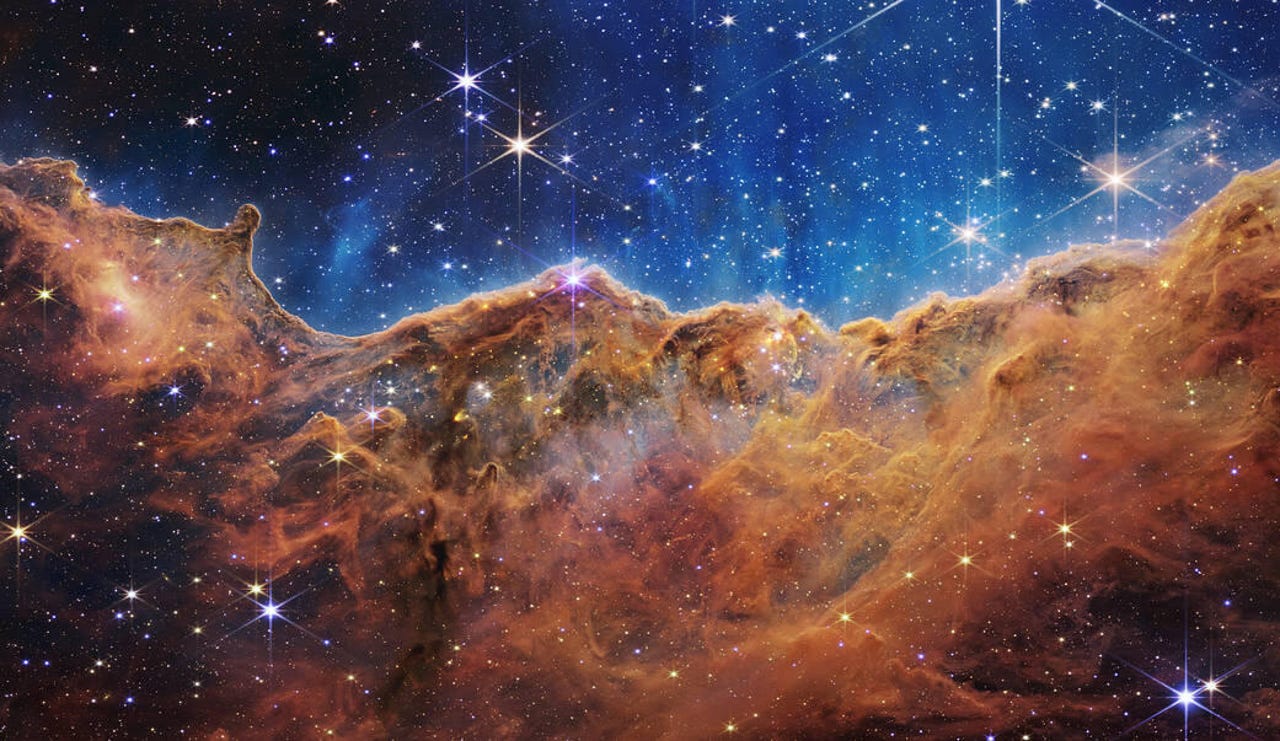
































NASA's James Webb Space Telescope reveals emerging stellar nurseries and individual stars in the Carina Nebula that were previously obscured.
Image: NASA, ESA, CSA, and STScIThis week, NASA and its partners released the first full-color images and data from the James Webb Space Telescope -- a feat of science and engineering that has given humanity it's farthest glimpse into space to date. The world has now seen astounding images of cosmic history -- of stars forming and dying, of water vapor on planets more than 1,000 light-years away.
As profound and enlightening as these images are -- already giving us a better understanding of the universe -- they're only the beginning of a decades-long journey for the JWST.
"We're making discoveries, and we really haven't even started trying yet," NASA Webb deputy program director Eric Smith said to reporters this week. The first pictures, he explained, "were more or less practice runs with the instruments... The promise of this telescope is amazing."
To understand the full potential of the JWST, you should start with two basic facts. First, the JWST is the largest, most powerful observatory ever put into space. Second, the JWST will be collecting data in space for a very long time.
The first images are just the results of 120 hours of observation -- five days of data. One of these -- the new image of Stephan's Quintet -- contains over 150 million pixels and is constructed from almost 1,000 separate image files. On Thursday, the Webb mission is publicly releasing around 40 terabytes of raw data gathered by the telescope.
Meanwhile, Webb has enough fuel to continue making observations in space for the next 20 years.
"It's an incredible amount of data that will come down," said Webb project scientist Klaus Pontoppidan.
Now that the data is coming down, it's time for the scientists to get to work.
The first year of Webb's work has been planned, with proposals selected through peer-reviewed competition from scientists around the world. When those scientists get the data, they will process the images and spectra.
"Some discoveries will come very quickly -- Webb is powerful enough to make some new results obvious," Jonathan Gardner, deputy senior project scientist for Webb, said to reporters last month. "Other discoveries will take more time as we push Webb and its instruments to the limits of their capabilities."
Scientists will publish the results in professional journals, but the Space Telescope Science Institute will also publish information and images, making those discoveries accessible to the public.
So far, Gardner said, the telescope is performing better than expected, with a sharper focus, and the instruments are also outperforming their requirements.
"The first images are going to be spectacular, but the science discoveries coming in the next year will be truly amazing," he said.
It's not just professional scientists that will be studying Webb's images. Already, the winning proposals include contributions from a "citizen scientist". Dan Caselden, a computer security professional from Massachusetts, is a co-investigator on a winning Webb-observing proposal. The proposal, called "Explaining the Diversity of Cold Worlds", will study a group of 12 brown dwarfs that all appear to have the same temperature, but still have different infrared brightness.
This fall, scientists -- professional or otherwise -- will be invited to submit their proposals for Webb's second cycle of Guaranteed Time Observations (GTO), which start in mid-2023.
The first cycle of observations will run the gamut of possibilities, from the deepest galaxy fields to the rockiest planets. In its first year in space, Webb will observe dozens of exoplanets, according to Webb astronomer Nestor Espinoza.
"From rocky planets to giant planets, hot, cold -- you name it," said Espinoza, an exoplanet expert. "All the diversity is out there in this first year, so I cannot wait to see what comes out of this."
Already, he noted, Webb will be bringing back observations from the TRAPPIST-1 system -- a solar system that includes planets that may be in the inhabitable zone.
Because Webb is an infrared telescope, it can capture information about the contents of a planet's atmosphere. The images captured by Webb complement the images taken by the Hubble Space Telescope, which captures visible wavelengths.
Webb project scientist Alex Lockwood likened the two telescopes to getting a physical examination as well as x-rays.
"When you get an x-ray... it's very different than what you see when you're looking at the person. But it tells you a lot more information, and it's complementary."
In addition to pairing images from Hubble and Webb, scientists will also be able to enhance their research with information from the LIGO mission, which measures gravitational waves.
While the images from Webb have already thrilled scientists, we may have to wait several years to fully appreciate its significance, said Ren
 Tags chauds:
Innovation et Innovation
l’espace
Tags chauds:
Innovation et Innovation
l’espace